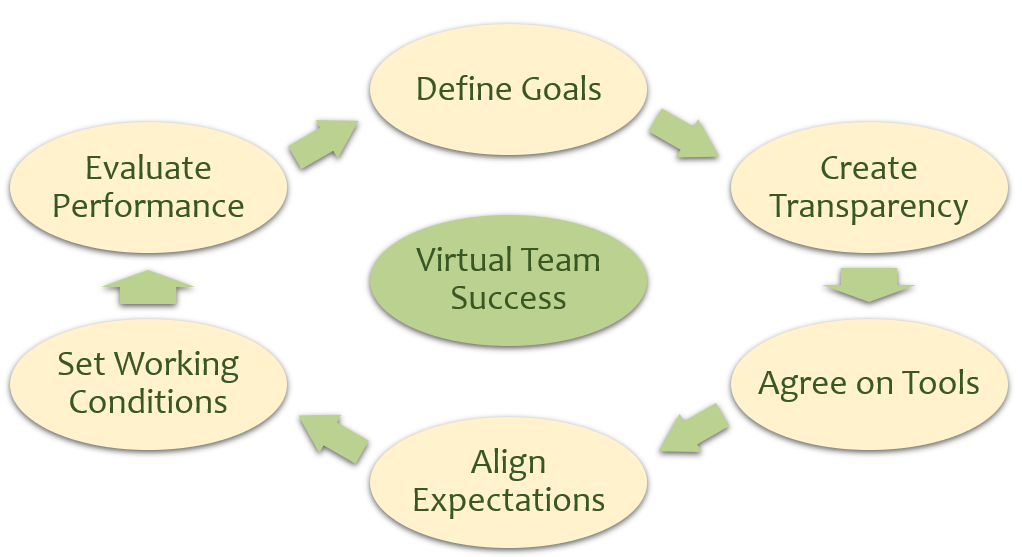Virtual Team Framework

Virtual team success depends largely on the same factors, that that of an on-site team. Clear goals, transparency about processes and tools, agreed expectations, favourable working conditions and reasonable procedures for performance tracking and personal evaluation will set any team on a good track.
However, what an onsite team needs for the best possible performance, becomes essential in a virtual team. The less than perfect processes, poor technical infrastructure or unclear communication can be smoothed out by going next door to clarify. Being unclear in a virtual team would lead to frustration, confusion, loss of time and motivation. Misunderstandings, when left unresolved can eventually grow into big challenges, both for the team dynamic, as well as for the organisational goal achievement. Your effort toward clarity in these success dimensions will power your virtual team for more motivation and greater achievements.
Create your own roadmap
If you see your team as a social ecosystem with a unique combination of goals, structures, personal sensitivities and needs, I would be happy to work together on tailoring your virtual transformation journey. You decide about scope and priorities, timeline and budget, stakeholders and participants, and we customise the success factors of the Virtual Team Framework to fit your team’s unique needs and to organically enhance the way your system works.
For the ready to use tips and insights, presented in a compact interactive and structured way, you are welcome to choose from the current workshop offer.
Define Goals
Guiding principles: leadership style, personal values, team values, team culture, vision and mission. Strategic planing: time horizon, customer orientation, budget priorities. Tactical goals: how should the team work together, how much work can be done remotely, how often to meet, what should be the roles, etc.
Align Expectations
Proactive and clear communication, appreciation, encouragement and feedback. Ways of addressing concerns and conflict resolution. Motivation by goal setting, personal engagement, interdependent goals, tailored development paths of team members. Team agreement, team values and code of conduct.
Create Transparency
Task management: who/ what/ by when/ in which form/ how often. Communication principles: communication matrix, types of meetings (whole team, one-on-ones, committees, other), frequency: how often, who participates, meeting rules, asynchronous communication, team chats.
Set Working Conditions
Organisation of work, staff training and technical enablement, accessibility of the infrastructure, flexibility of working arrangements, roles and responsibilities, decision making and delegation, relationship building, networking and team spirit. Fun and insider content (traditions, anecdotes, celebrations).
Agree on Tools
Shaping team processes: reporting, on-/ offboarding, task allocation, decision making, escalation procedures, information sharing, knowledge accumulation. Which tools to use: dashboards, workflows, messaging, file sharing. Technology adoption road map: technical training and consistency of tools use.
Evaluate Performance
Key Performance Indicators (KPIs), key metrics, measure the right things, set the right incentives. Accepted reporting process: make the work visible and stay on track about the tasks (avoid loss control); methods and tools how to evaluate individual performance: time spent versus result achieved.
Address most common challenges
Many organisations face similar challenges, and so I have put a catalogue of the most common pitfalls organisations might see in their virtual teams. If you think, your team might benefit from a short and structured workshop on communication, work organisation, tools and processes or any other of the listed topics, I will be ready to share the best practice approaches and give you tools and methods on hand, which you can plug and play right away.
Team spirit, roles and commitments
- Build relationships and trust network over distance, get to know your colleagues better (knowledge map, personal map, personal contact in remote teams).
- Defining measurable goals, common values. This creates a sound basis for working remotely, aligning expectations and increasing commitment to the results.
- Sharpen roles definitions.
- Create greater commitment.

Performance Engagement
- Assigning tasks and responsibilities appropriate for the person and the situation and motivate employees remotely.
- How to delegate tasks correctly and give feedback at a distance.
- Organisation of daily work and staying on track with tasks (avoid loss control).
- Interdependent goals and methods and tools for evaluation of individual performance (time versus result based).

Communication and Online Meetings
- Synchronous and asynchronous communication
- Great meetings essentials and best practice techniques
- Communicate effectively on a regular/ systematic basis and run better virtual meetings
- Use different communication channels, adapted to the specific needs (email, video, chat, project management and collaboration tools)

Tools and Processes.
- If teamwork relies on technology, it needs to be organised in the best possible way:
- Clear, simple and accepted processes.
- Reliable and secure tools
- Consistent and thoughtful application.
- Team collaboration tools for staying informed, for staying connected,
- Current technological trends: how to find the optimal tool set?

Conflict resolution
- Conflict prevention better than conflict resolution
- Types of conflicts: What it is really about?
- Ways of escalaiton and de-escalation
- Appreciation and feedback
- Early warnings
- Risk factors: written communication + time lag

Informal communication
- Talk more, exchange small chats or check-ins
- Positive team-bonding activities and celebrations
- Meet without the boss
- Pizza party, coffee or happy hours time
- Be human, gentle and go deep
- Schmooze: join and share on same interest channel



